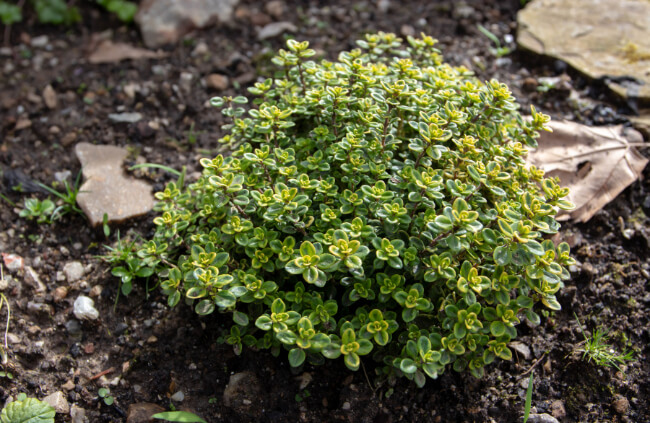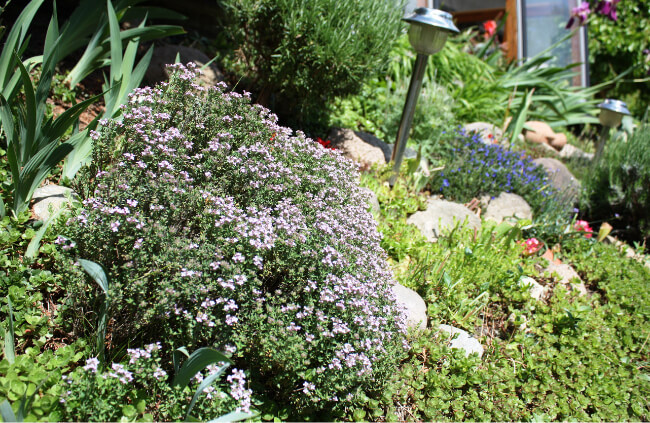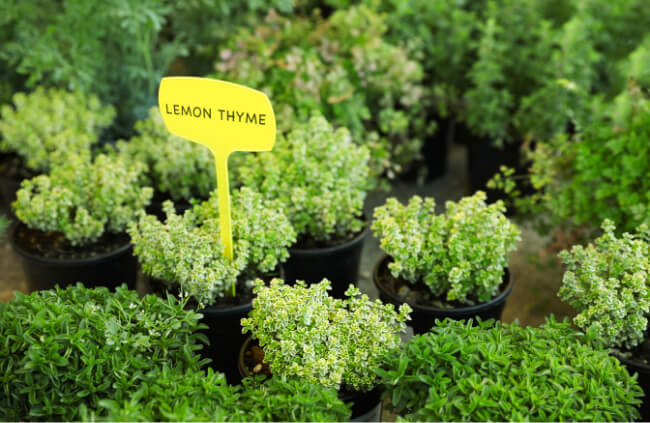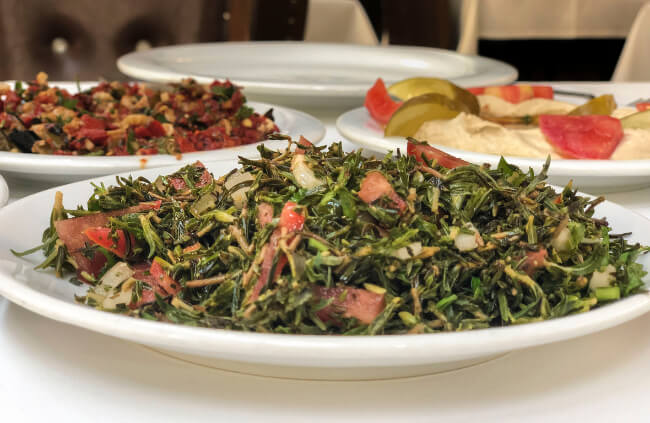I believe that Lemon Thyme is almost certainly a must-have addition for not only herb garden enthusiasts but almost anyone who wants an ornamental that can also double as delicious herbage with a plethora of culinary applications.
This Mediterranean herb is an evergreen perennial that features lovely lemon-scented foliage, gorgeous yellow to lime green diamond-shaped leaves and alluring tubular lilac flowers in summer.
Apart from its already impressive characteristics, the plant also has a useful mat-forming habit, perfect for many functional and ornate applications within gardens.
In this article, I will be sharing how you can grow and care for this aromatic treasure in your garden to reap the most out of its ornamental influence in your landscape as well as its nutritious leaves in the kitchen.
More...

Family: | Lamiaceae |
|---|---|
Genus: | Thymus |
Species: | T. citriodorus |
Origin: | Southern Europe (Mediterranean) |
Common Names: | Lemon Thyme, Citrus Thyme |
Location: | Indoor or outdoor |
Type: | Herb |
Growth: | 15 to 30 centimetres tall, 30 to 45 centimetres wide |
Sun requirements: | Full sun |
Foliage Colour: | Green |
Flower Colour: | Lilac |
Flowering: | Summer |
Edible Parts: | edible flowers and leaves |
Maintenance level: | Low |
Poisonous for pets: | Non-toxic to cats and dogs |
Introducing Lemon Thyme
I know not all of us have the luxury of a large garden so thankfully, lemon thyme is suitable for any outdoor space regardless of size or setting where it will easily add appeal, interest and magnificent bursts of citrusy scents throughout the space.
With its highly attractive qualities, low-maintenance nature and greatly varied culinary applications, this plant is an excellent addition to almost any garden.
Botanically labelled Thymus citriodorus, the plant's common names include Lemon Thyme and Citrus Thyme. Part of the Lamiaceae family, lemon thyme is native to Southern Europe but occurs mostly in the Mediterranean regions.
Recent DNA analysis of the plant has suggested that it is not a hybrid or cross as previously believed, but is rather a distinct species as first described in 1811.
It is most suited to warmer climates so it makes for a great species to establish in most Australian gardens. Considered fast-growing, this citrusy herb will typically reach about 15 to 30 centimetres tall and 30 to 45 centimetres wide.
The nectar-rich blooms will be useful for native bees and butterflies throughout summer. In gardens, the plant will grow well alongside cabbage as it helps to deter the Cabbage Root Fly. It will also grow well alongside onions and even roses as the growing conditions are very similar.

Citrus Thyme Landscaping Applications
Citrus thyme offers a wide range of applications within gardens.
Here are some of the most common uses for this species and its cultivars:
- Groundcover
- Rock gardening
- Container gardening
- Herb gardening
- Border planting
- General shrubbery
- Xeriscaping in hot and arid regions
Popular Lemon Thyme Varieties
Most growers choose a cultivar for its foliage colour and the aromas of different fruity notes. Here are some of the most popular cultivars and varieties of this species.
Lemon Supreme
Featuring a more intense lemony scent and flavour in its foliage, this cultivar also produces light mauve blooms and is a very vigorous grower. This plant is more hardy than other varieties so it’s a good pick for more hostile conditions.


Get Your Free Guide:
Master Growing Australian Natives eBook
A Must Have Complete Guide for Every Australian Garden
Get Your Free Guide:
Master Growing Australian Natives eBook
A Must Have Complete Guide for Every Australian Garden
Lime Thyme
This mounding groundcover cultivar sports bright apple-green leaves with a powerful lime scent and flavour as well as lavender-pink blooms in summer. A great pick for those who prefer lime notes over lemon.
Orange Thyme
This variety is unusually low-growing, perfect for forming a dense ground cover around the garden. It is noted for its orange-forward citrusy scent and flavour profile.
Silver-Edged Lemon Thyme
As its name suggests, this cultivar boasts silver-edged green leaves with prolific pink flowers to boot. Its flavour and aroma are milder than other varieties but its highly ornamental qualities easily make up for that.
Creeping Golden Lemon Thyme
Adorned with shiny dark green lemon-scented leaves variegated in golden hues, this cultivar also features lovely lavender flower spikes in season and a dense, creeping growth habit.
Golden Lemon Thyme
This golden variety was cultivated to produce strongly variegated yellow-gold foliage that can add richness and striking pops of colour to outdoor spaces. It was also bred to have less pungent aromas and flavours in its leaves than its parent plant. This is a great pick for those who want to take advantage of the plant’s ornamental qualities rather than its tucker potential.
How to Grow Lemon Thyme in Australia
This species and its cultivars can be reliably grown from seed or propagated using cuttings. Seed-grown plants can be slow to germinate whereas cuttings strike far sooner.

Propagating Lemon Thyme from Seeds
- Prepare seed-starting trays by filling each cell with a quality seed-raising mix.
- Sow 2 to 3 seeds into each cell and mist to keep the growing medium consistently moist.
- Place a domed cover of the trays as this will help to keep the seeds warm and the soil moist and temperate.
- Place the trays by a bright window or under a growing light on a heating mat.
- Once the seeds have germinated, you can remove the dome cover and then place the seeds near a bright area that gets some indirect airflow. Airflow will help ensure robust roots and a stronger plant.
- Once the plants have reached a height of about 8 to 10 centimetres, you can move them into bigger containers to allow them to mature further before transplanting outdoors.
Propagating Citrus Thyme Using Cuttings
- Take stem cuttings from a healthy established plant that are about 10 to 12 centimetres in length.
- Cut just below the leaf nodes using sharp and sterile scissors or pruning shears.
- Remove some of the leaves below the nodes then dip the cut end of the cuttings into some rooting hormone.
- Prepare containers filled with quality potting mix or a seed starting soil then plant the cuttings into the medium to about a third of the depth.
- Water well after planting then place the cuttings in a location that gets plenty of light. Keep the soil lightly moist at all times.
- New roots should start to form within a few weeks. Allow strong root systems to develop then transplant into a larger container to grow further.
Best Conditions for Planting Lemon Thyme
The best time of the year to plant this species in the garden would be around late spring to early summer. It can be planted in a fixed spot in the garden or containers on sunny verandahs.
You can also grow indoors but this requires more specific attention to detail.
Overall, this herbaceous plant is mostly carefree and shouldn’t give you too much hassle while growing and caring for it.

Ideal Light
This plant certainly prefers full sun. Plenty of light will ensure overall plant vigour. Pick a bright, sunny and open position for your plant. While it can tolerate some shade, the foliage will be more vibrant with a stronger aroma in full sun.
Soil Needs
Citrus thyme can tolerate many soil types so long as the soil is well draining. It will perform best in dry to medium soils with a neutral to slightly alkaline pH level.
Temperature and Humidity
This plant thrives in warm, dry conditions, which is why it looks its best and blooms in summer. It will go dormant during the cooler months but will likely remain green all year in Australia.
Ideal soil temperature when planting is between 15°C and 25°C. Ideal average garden temperatures are between 20°C to 30°C. General to slightly elevated garden humidity is fine.
Indoor Growing Tips
This species can be grown indoors as long as it receives bright light daily. Be sure to use a quality potting mix in your container. A good recommended mixture to start is three parts seed mix, two parts organic compost, one part vermiculite and one-part general topsoil. This combination should allow for the most ideal soil conditions for indoor growth.
How to Care for Lemon Thyme
Once established, this herb is tolerant to drought and is quite hardy overall. It takes about 1 to 2 years to establish itself in gardens.
Watering Needs
Requires little water once established as it prefers dry conditions. Water well once the soil is dry to the touch. On average, water every 1 to 2 weeks. This plant does not enjoy wet feet so try to avoid overwatering.
Fertilising
Fertilising is usually not recommended for most herbs. Instead, mix some organic compost into your soil when planting then add a fresh layer annually in spring.
Mulching
Add a decent layer of organic mulch around the base of the plant annually in summer until it is established. This will assist with proper moisture retention in the soil.
How to Prune Citrus Thyme
Prune after flowering to remove spent flower heads and keep the plant producing rich, new foliage. Regular light pruning during the active season will ensure the plant remains filled out.
Repotting
Your plant may need to be repotted every 1 to 2 seasons depending on its growth rate and the size of the container. Once the roots start to show at the bottom of the container, it’s time to repot.
Repot into a container that is at least 1 to 2 sizes larger than the current container and be sure to plant into a fresh soil mixture. Water well after repotting.
Possible Citrus Thyme Problems
This species as well as its cultivars are practically disease and pest free. Overwatering can lead to root rotting issues so be sure to monitor your watering properly.
Harvesting and Using Lemon Thyme
The leaves of lemon thyme have been used for centuries to treat illnesses and add flavour to many kinds of dishes. It is a highly variable herb that will make for an excellent addition to your spice rack and it is also considered one of the most useful herbs you can grow at home.
It looks almost identical to regular thyme and tastes quite similar, but features a much more prominent citrusy scent and flavour profile. It is said to have a strong but balanced flavour.
The leaves have a subtle but zesty essence of lemon or citrus paired with light herbal flavours of thyme. Lemon thyme is also less bitter than regular thyme.
Traditionally, this plant was used as a medicinal herb or folk remedy to treat many illnesses as it contains strong antiseptic and antibiotic qualities. Today, it is commonly used to make essential oils, respiratory aids, deodorants, perfumes and even skincare products.
How to Harvest Lemon Thyme Leaves
Simply pluck healthy leaves from the plant as needed. Rinse the leaves before use to remove any dirt and debris. Being an evergreen, you should have a good supply of fresh leaves throughout most of the year.

How to Use Lemon Thyme
There are so many ways in which you can use these delicious and nutritious leaves. It can make for a great substitute for regular thyme thanks to its less bitter flavour but ultimately, feel free to use the herb as you need and get as creative as you like.
Here are some common uses for Thymus citriodorus:
- The leaves can be eaten raw in salads.
- The leaves can be used as a fresh or dried flavouring herb in cooking and for herbal teas.
- Add to any recipe that needs a burst of lemon flavouring. It is best used to flavour chicken, fish, vegetables and even desserts.
- You can use dried and crushed leaves in stuffings or to flavour soups and omelettes.
- This is a useful herbal tea as it contains antiseptic and antibacterial properties that can help with reducing cold symptoms, alleviate coughs and assist with tonsillitis.
- It can be used externally for fungal infections, bites or aches and pains.
- This herb is perfect for Italian-style cooking paired with ingredients like garlic, olive oil and tomatoes.
If you’re also interested in growing regular thyme, be sure to refer to our detailed growing guide below for everything you need to know: How to Grow and Care for Thyme
Lemon Thyme Frequently Asked Questions
What does lemon thyme do for you?
The leaves are rich in vitamins, minerals and antioxidants so lemon thyme is great for assisting with strengthening your immune system and promoting good health overall. Its anti-inflammatory and decongestant properties can also help to ease your respiratory tract and soothe irritating coughs.
Can you eat Thymus citriodorus?
Yes, the leaves of this herbaceous plant can be eaten raw or used fresh or dried as a flavouring herb for cooking and herbal teas.
Can lemon thyme grow in shade?
Yes, lemon thyme plants can be grown in shade but they will bloom less and their fragrance will be far less intense. Try to aim for at least some dappled sun rather than deep shade.
Is lemon thyme easy to grow?
One of the most favoured thyme species, lemon thyme can perform well in bright spots indoors or in sunny positions in the garden. Either way, it is considered easy to grow and care for.
Does lemon thyme repel mosquitoes?
Yes, to keep mosquitoes away, cut a stem or two from your plant then crush the leaves in your fingers and rub the extract on your skin. Crushed lemon thyme has excellent mosquito-repelling qualities.
Does lemon thyme come back each year?
Being a hardy perennial, lemon thyme will keep coming back year after year in good conditions.
What should you not plant next to lemon thyme?
While Thymus citriodorus grows well alongside cabbage, onions and even roses, it will not perform well with companion plants like chives, cilantro or basil and these plants have very different growing requirements and may compete for the same nutrients in the soil.
Does lemon thyme prefer pots or ground?
This species will perform equally well in containers and garden beds as long as it is in a bright sunny location and the soil is well draining.
Should I cut back lemon thyme?
It is recommended to cut back lemon thyme by about 6 to 8 centimetres during its growing season to encourage strong and vigorous growth.
Why does my lemon thyme keep dying?
Most varieties of thyme usually die because of root rot from overwatering. They are very sensitive to wet feet so they should only be watered when the soil is completely dry to the touch. Old age and over-fertilising can also cause them to die rather quickly.
Keen on growing more herbs in your garden? Check out our comprehensive guide to growing curry trees in Australia.
Enjoy One of the Most Beloved Thyme Species with the Lovely Lemon Thyme
If you’re like me and absolutely love growing delicious herbs that can elevate almost any dish, then lemon thyme is a must-have addition to your garden and spice rack.
Apart from the versatility the leaves offer in the kitchen, the plant itself is just an all-around stunner. With its vibrant lime green foliage, profusions of lilac flowers in summer and its useful growing habit, this citrusy herb can add appeal and interest to any Australian garden, big or small.
Enjoy one of the most useful and easy-to-grow herbs at home with the lively and lovely lemon thyme plant.
Published on June 2, 2023 by Maisie Blevins
Last Updated on February 23, 2024




